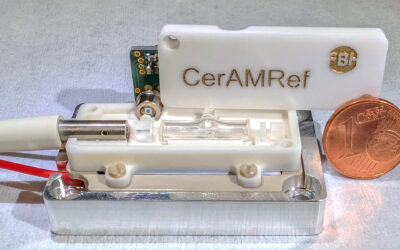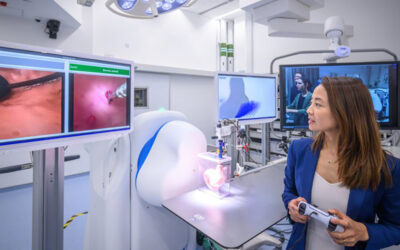Music can move you and make you move. Perhaps it comes as no surprise then that sound can be used to move matter itself. Acoustic manipulation uses precisely-controlled beams of sound waves to push and pull objects, generating forces that influence the motion of particles with no physical contact at all.
A new approach produces helical waves that provide an additional dimension of control: harnessing the “spin” of a beam to rotate suspended particles, improving precision and enhancing the potential of contactless control for everything from cellular research to healthcare and communication technology.
It’s all in the spin
Conventional “acoustic tweezer” technology uses acoustic beams that provide linear force, pushing and pulling objects forward and back. Small objects, such as particles, microbeads, or cells, are trapped inside the acoustic field and respond to the pressure created by the streaming sound waves.
The new technique, described in Advanced Intelligent Systems and developed by a team of researchers from the Intelligent Medical Ultrasound Lab at Fudan University, instead uses what they call orbital angular momentum beams — acoustic waves with a very different structure.
“Orbital angular momentum beams differ from traditional acoustic beams in that they have a helical wavefront and a central ‘dark’ region, creating an acoustic potential well,” said one of the corresponding authors, Xue Jiang, professor in the School of Information Science and Technology at Fudan University. “This acoustic well affords the trapping and precise manipulation of particles within its confines.”
Particles are suspended in the beam’s central ring, like a marble inside a slinky toy, and the helical structure gives the researchers control of the particles’ rotation as well as its linear position.
“This new, highly specialized technique isn’t just a small improvement; it dramatically increases the orbital angular momentum beam quality,” said Dean Ta, one of the study’s corresponding authors and professor at Fudan University. “It’s this enhancement that led to the creation of the twisted ultrasonic motor, a device capable of stable particle rotation in free space.”
The device is built around an array of individual transducers — devices that convert electrical signals to acoustic waves — firing in intricate sequence and creating the wave’s helical structure. This approach not only gives rotational control, but greatly improves precision.
The stable, spinning, donut-shaped beam results in smoother, more predictable interactions with particles than ever before. To achieve these improvements, the researchers had to tackle the design process from a new angle.
Working backwards
The team took a novel approach to overcome the limited quality of previous beams. Instead of considering the constraints and conditions of the experimental setup then computing the equations that would predict the outcome of a system — a strategy known as “direct design” — they used “inverse design” where they started with the final goal and worked back to determine what conditions would lead to their desired beam.
“Direct design is like setting up the initial pieces on a chessboard and then predicting the moves,” said Jiang. “This is particularly effective for well-understood systems where the relationships between variables are linear or can be approximated as such. Inverse design, however, starts with the final goal and works back to determine the conditions that would produce this outcome. This is akin to reverse engineering the optimal solution.”
The criteria they input included optimizing timing across the array of transducers to create higher-quality beams with less interference and more reliable consistency, and the algorithm progressively tweaked the relevant variables until it achieved the final beam properties.
“This method is especially potent for complex, non-linear systems where the relationships between variables are not straightforward,” said the first author of this work, Chuanxin Zhang.
In unpicking the subtle parameters that dictate the quality of the beams, the team have refined a technology that is already showing great promise in real-world application.
A range of applications
Being able to trap and precisely control tiny elements is not an abstract scientific challenge — there are direct, practical applications in healthcare and industry.
Targeted drug delivery is particularly exciting to the team. “Here, the focus would be on using the twisted ultrasonic motor technology to move drug-encapsulated micro-carriers with high precision through various types of biological fluids,” said Jiang. “The trapping mechanism, enabled by a ring-shaped acoustic potential well, could serve as a ‘vehicle’ that carries these micro-carriers directly to specific cells, tissues, or organs.”
In addition, the rotational control could even be used to trigger drug release at the desired target site. “This free-wheeling control could be pivotal in reducing side-effects and increasing the efficiency of the treatment,” said Jiang.
Other potential uses range from research to industry. Biological researchers manipulating samples in free space without risking contamination or deformation can use this approach to rotate samples and study the impact of mechanical forces of cell structure and function.
Orbital angular momentum beams have been proposed as wireless communication systems, able to transmit data at much higher capacities than traditional radio waves. To realize this potential, engineers will rely on the sort of smooth signal and control provided by the team’s advancements.
“High-quality [orbital angular momentum] beams with a high signal-to-noise ratio could have important implications for […] communications. The high quality and purity of these beams could result in reduced signal loss and interference, thus enhancing the reliability of communication systems,” said Zhang.
As the technology continues to improve, the range of potential uses will grow, meaning sound will be able to carry much more than just a tune.
Reference: Xue Jiang, Dean Ta, et al., Inverse-Design Methodology for Generating Twisted Ultrasonic Motor in Free Space, Advanced Intelligent Systems (2023). DOI: 10.1002/aisy.202300255

















